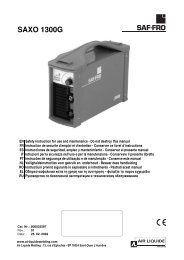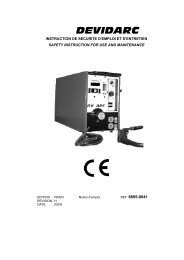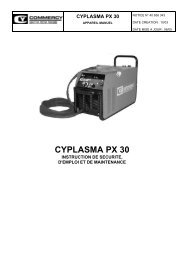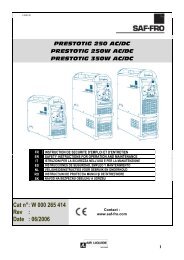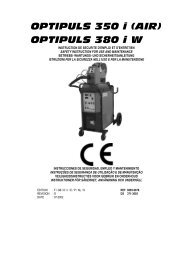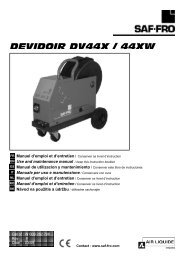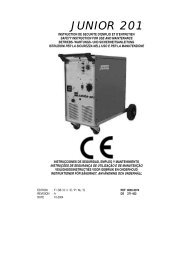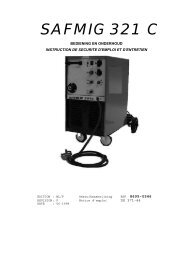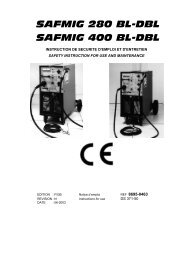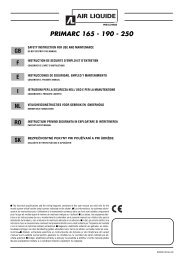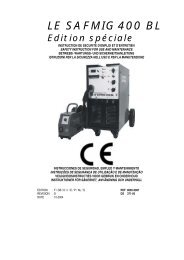Create successful ePaper yourself
Turn your PDF publications into a flip-book with our unique Google optimized e-Paper software.
2 – MISE EN SERVICE 2 – STARTING UP<br />
2.1. DEBALLAGE DE L'INSTALLATION 2.1. UNPACKING THE SET<br />
<br />
<br />
L’installation est livrée dans un emballage plastique thermo rétractable<br />
positionné sur un socle en bois. Dégager la housse du socle.<br />
Retirer la source de puissance de son socle en bois à l'aide d’élingues ou<br />
d’un chariot élévateur.<br />
<br />
<br />
The set is delivered in a shrink pack on a wooden base. Remove the<br />
cover from the base<br />
Remove the power source from its wooden base with slings or a fork lift<br />
truck.<br />
ATTENTION : la poignée n'est pas prévue pour élinguer le poste,<br />
mais pour faciliter le passage d'obstacles (câbles dans un atelier,<br />
passage d'une marche de 10 cm).<br />
WARNING: the handle is not intended for slinging the set, but only for negotiating<br />
obstacles (cables in a workshop, a 10 cm step, etc).<br />
ATTENTION : la stabilité de l'installation est assurée jusqu'à une<br />
inclinaison de 10°.<br />
WARNING : equipment stability is ensured up to an agle of 10°.<br />
2.2. RACCORDEMENT ELECTRIQUE AU RESEAU 2.2. ELECTRICAL CONNECTIONS TO THE MAINS<br />
Le <strong>CITOPULS</strong> est un poste 400 V triphasé.<br />
The <strong>CITOPULS</strong> is a 400 V 3-phase welding set.<br />
Les fréquences réseau acceptées sont : Mains frequencies accepted :<br />
50 et 60 Hz<br />
50 and 60 Hz<br />
Si votre réseau correspond, il suffit de brancher une prise "triphasé + terre" à<br />
l'extrémité du câble d'alimentation.<br />
If your mains supply corresponds with these requirements, simply fit a 3-phase + earth<br />
plug to the end of the supply cable<br />
2.3. RACCORDEMENT DU DEVIDOIR 2.3. WIRE FEEDER UNIT CONNECTIONS<br />
ATTENTION<br />
A effectuer générateur hors tension.<br />
Raccorder le faisceau au dévidoir en respectant les emplacements des connecteurs.<br />
Raccorder l’autre extrémité du faisceau au générateur.<br />
Relier la torche de soudage MIG au dévidoir.<br />
Vérifier la bonne circulation du liquide de refroidissement.<br />
Régler le débit de gaz<br />
Consulter l'instruction d'emploi du dévidoir.<br />
CAUTION<br />
To be carried out with the power source turned OFF.<br />
Connect the harness to the wire-feed unit, being careful to comply with the locations of<br />
the connectors.<br />
Connect the other end of the harness to the power source.<br />
Connect the MIG welding torch to the wire-feed unit.<br />
Check that the cooling liquid circulates freely.<br />
Adjust the gas flow rate.<br />
Please consult wire feeder instruction.<br />
2.4. RACCORDEMENT DE LA TORCHE AU DEVIDOIR 2.4. WIRE FEEDER TORCH UNIT CONNECTION<br />
SI TORCHE AIR : arrêt du GRE dans SETUP du générateur.<br />
SI TORCHE EAU : vérifier le fonctionnement automatique ou marche forcée du GRE<br />
(voir SETUP du générateur).<br />
2.5. RACCORDEMENT DE L'ARRIVEE DE GAZ SUR<br />
DETENDEUR<br />
Le tuyau de gaz est associé au faisceau qui relie le générateur au dévidoir. Il suffit de<br />
le raccorder à la sortie du détendeur sur la bouteille de gaz.<br />
Mettre la bouteille de gaz sur le chariot à l'arrière du générateur et fixer la<br />
bouteille à l'aide de la sangle.<br />
Ouvrir légèrement puis refermer le robinet de la bouteille pour évacuer<br />
éventuellement les impuretés.<br />
Monter le détenteur/débitmètre.<br />
Raccorder le tuyau gaz livré avec le faisceau du dévidoir sur la sortie du<br />
détendeur.<br />
Ouvrir la bouteille de gaz.<br />
En soudage, le débit de gaz devra se situer entre 10 et 20L/min.<br />
FOR AN AIR TORCH : stop the cooling unit via generator SETUP.<br />
FOR A WATER TORCH : check automatic or forced operation of the cooling unit (see<br />
generator SETUP).<br />
2.5.GAS INLET CONNECTION ON PRESSURE<br />
REGULATOR<br />
The gas hose is fitted with the harness, coming from the wire feed unit to the power<br />
source. Nnect this hose to the output of the regulation.<br />
Place the gas cylinder on trolley at the rear of the power source and fasten<br />
the cylinder by means of the strap.<br />
Open the cylinder valve slightly and close it to allow any impurities to<br />
escape.<br />
Fit the pressure regulator/flow meter<br />
Connect the gas hose delivered with the wire-feed unit harness to the<br />
pressure-regulator outlet<br />
Open the gas.<br />
In welding, the gas flow rate should be between 10 and 20l/min<br />
ATTENTION<br />
Veiller à bien arrimer la bouteille de gaz sur le chariot en mettant en<br />
place la sangle de sécurité.<br />
CAUTION<br />
Be careful to secure the gas cylinder by putting a safety strap back in place.<br />
2.6. RACCORDEMENT DE LA TORCHE 2.6.TORCH CONNECTION<br />
La torche de soudage MIG se raccorde à l'avant du dévidoir, après s'être assuré<br />
qu'elle soit bien équipée des pièces d'usures correspondantes au fil qui va être utilisé<br />
pour le soudage.<br />
Pour cela se reporter à la notice accompagnant la torche.<br />
Welding torch is to be connected on the front side of the wire feed unit. first you must<br />
verify that consumable parts of this torch are in accordance with the type of wire you're<br />
going to use for welding.<br />
Please look at the manual delivered with the torch for this verification<br />
<strong>CITOPULS</strong> 7



